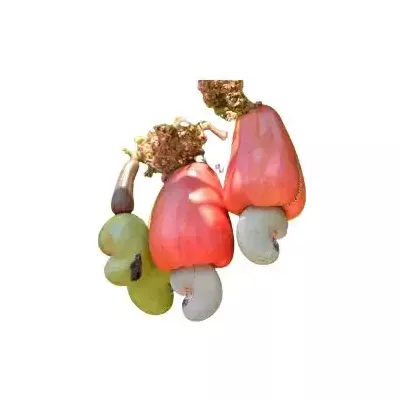



Enjoy cashew fruit straight from your backyard or terrace garden. Grafted plants are suitable for growing in a container too.

Pay using UPI, Card or Netbanking

Shipping within 3 working days
Anacardium occidentale, commonly referred to as cashew, is a tropical evergreen tree native to Brazil. In India it's known by the names "Kaju" in Hindi and "Andiparippu" in Malayalam.
The name "cashew" comes from the Portuguese word for "fruit," caju. This tree-borne fruit of the cashew tree was brought to India by the Portuguese during the 16th century.
The cashew plant is a slow-growing tree that can reach up to 12 metres tall. It has an open growth habit and has a dense, bushy crown. Tolerant of various soil conditions such as sandy or clayey ones, the tree thrives here.
Cashew plant prefers a warm, humid climate with average temperatures ranging from 20degC to 35degC and a slightly acidic to neutral soil.
Cashew plant thrives best in full sun, though it can tolerate partial shade too.
Cashew plant requires regular watering, especially during dry spells. Otherwise, this plant is relatively low maintenance with minimal pruning required.
Cashew fruit is a juicy delectable treat with an intense flavour. There are red and yellow varieties available; typically consumed raw or in juice form to get rid of any strong aroma or aftertaste. Mildly cooking the fruit may help eliminate this strong aroma altogether if that's what puts you off.
Cashew nuts also make nutritious snacks as well as being used in many culinary dishes.
Feni, a popular Goan liquor, is made with cashew fruit.
The seed of cashew fruit is kidney-shaped and about 2 to 3 cm across. It has an outer hard shell called the cashew nut that contains one single seed inside.
Raw seeds contain milky juice that can cause blisters. On the other hand, when ripened fruits have dried out, these nuts would be dry and crisp.
Cashew fruit juice is often fermented to make a tonic (Arishtam) to be used for stomach ailments like diarrhoea, constipation and stomach ulcers. Furthermore, the fruit possess anti-inflammatory and antioxidant properties.
Cashew plants thrive in both tropical and subtropical climates and can be found throughout India. Due to its drought-tolerance, homestead planting requires less upkeep than commercial plantations. Grafted plants will start flowering after 6-8 months. But these should be removed till two years, in order to promote healthy plant growth.
A spacing of 7 to 10 metres is needed when planted on the ground. If space is an issue, grafted trees can also be pruned into small trees that can be placed into drums or other containers. Cashew plant can be pruned to maintain its shape and size.
Cashew trees are grown for both fruit and nuts but primarily grown for their nuts.
Data sheet